CUHK Art Museum Presents Exhibitions on Bronze Mirrors and Oracle bones
The Art Museum, an integral part of the Institute of Chinese Studies, The Chinese University of Hong Kong (CUHK), will present two exhibitions from 12 August to 17 September 2017 to mark the Institute’s Golden Jubilee. The exhibitions are Universe within Inches: Bronze Mirrors Donated by Prof. MARK Kai-keung and A Legacy of Elegance: Oracle Bones Collection from The Chinese University of Hong Kong. Members of the public are welcome to visit the exhibitions. Admission is free.
The opening ceremony for the two exhibitions was held today (11 August). Those present included Prof. MARK Kai-keung; Prof. CHEUNG Mui-ching Fanny, Pro-Vice-Chancellor and Vice-President of CUHK; Prof. Leung Yuen-sang, Director of the Institute of Chinese Studies, CUHK; Prof. YU Chai-mei Jimmy, Head of United College, CUHK; Dr. LAU Lai-che Maria, Deputy University Librarian, CUHK; Ms. GAN Qi, Director of The Chinese University Press; Mr. Christopher Mok, Chairman, Advisory Committee of the Art Museum; and Prof. YIU Chun-chong Josh, Director of the Art Museum, CUHK.
Universe within Inches: Bronze Mirrors Donated by Prof. MARK Kai-keung
The mirrors donated by Prof. Mark Kai-keung not only enrich the Art Museum’s collection but also constitute a major contribution to the history of material cultures. Universe within Inches: Bronze Mirrors Donated by Prof. MARK Kai-keung features 35 mirrors in Mark’s collection. The earliest ones can be traced to the Warring States and Western Han periods, and the majority of them are from the Song-to-Qing period. There is a variety of mirror shapes in the collection, including round, square, eight-lobed, octagonal, peach-shaped, and bell-shaped, and rich decorative patterns appear on these mirrors. This exhibition is divided into four units: 1. Mirrors with animal, vegetal, figural, or architectural patterns; 2. Mirrors with mysterious images and script; 3. Mirrors inscribed with wishes; 4. Production locations and workshops associated with the mirrors.
The accompanying catalogue Universe within Inches: Bronze Mirrors Donated by Prof. MARK Kai-keung edited by Dr. Li Kin-sum Sammy, guest curator of the exhibition and Assistant Professor of the Department of History, Hong Kong Baptist University, is published to offer a fresh perspective on Chinese bronze mirrors in addition to showcasing previously unpublished specimens.
A Legacy of Elegance: Oracle Bones Collection from The Chinese University of Hong Kong
CUHK is the largest repository of oracle bones in Hong Kong, including forty-four oracle bones donated by Mr. Deng Erya’s family to United College and twenty-seven by Mr. Lee Yim to the Art Museum. On the occasion of the United College's sixtieth anniversary and the Golden Jubilee of the Institute of Chinese Studies, A Legacy of Elegance: Oracle Bones Collection from The Chinese University of Hong Kong is jointly presented by United College, the CUHK Library and the Art Museum as a celebration event. The exhibition features the oracle bones from the CUHK Collection, the oracle-bone and bronze scripts from the Art Museum Collection, and publications on oracle-bones studies from the CUHK Library Collection. Exhibits include calligraphic works and monographs by well-known scholars such as Luo Zhenyu, Deng Erya, Tung Tso-pin, Rong Geng, Shang Chengzuo, Feng Kanghou, Lee Yim and Jao Tsung-i.
The specialist catalogue A Legacy of Elegance: Oracle Bones Collection from The Chinese University of Hong Kong edited by Dr. Li Zong-kun of the Institute of History and Philology, Academia Sinica, Taiwan, is intended for both the expert and the uninitiated yet educated reader. The two essays written by Dr. Ho Pik Ki, Peggy, Research Associate of the Art Museum, CUHK reveal the achievements made by CUHK on oracle-bones studies and art.
Details of the exhibitions are as follows:
| Exhibition Period: | 12 August to 17 September 2017 |
| Exhibition Venue: | Art Museum, Institute of Chinese Studies, CUHK |
| Opening Hours: |
Mondays to Wednesdays, Fridays and Saturdays: 10:00am-5:00pm |
| Closed: | Thursdays (Except Public Holidays) |
| Enquiries: | 3943-7416 |
Attachment: Highlighted exhibits
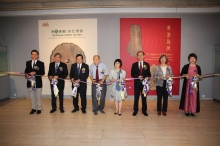
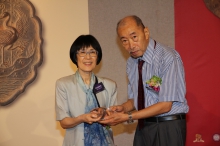
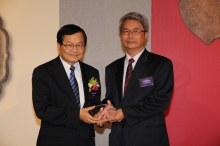
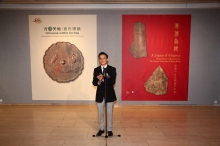
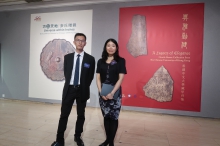
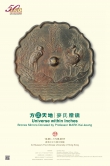
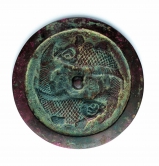
Jin, 12th–13th cent.
Diam. 19.4 cm, rim h. 0.75 cm, w. 1508 g
Art Museum Collection
Gift of Prof. MARK Kai-keung
Mirrors with the double-fish pattern dating to the Jin period were very popular, and their designs, production techniques, and regional features all merit discussion. This mirror has a wide rim; within the circular rim there are two carp-like fish. The wave patterns surrounding the carp and the scales of the carp are carefully carved. This required sophisticated and extremely fine carving skills. We can see their heads and major parts of one side of their bodies. Also, their bodies twist at the end of their tails, and this allows us to see the other sides of their bodies. The fish are vividly represented on the mirror and look like they are playing in the river. The mirror is large, thick, and extremely heavy. It is uncomfortable to hold the mirror by grasping a silk fabric threaded through its loop. Thus, it might have been placed on a stand and is not suitable for a user to hold with two hands to rotate. The mirror might not be a daily reflective object for its users but rather a precious item primarily for display. Similar mirrors have been collected by many museums in China, but clear records of provenance are pointing to the Jilin and Heilongjiang areas. This reflects the popularity of the mirrors in these areas, which fell within the territories of the Jin state.
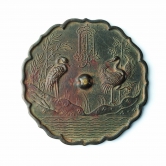
Song, 11th–13th cent.
Widest width (wid.) 12.97 cm, rim h. 0.38 cm, w. 290 g
Art Museum Collection
Gift of Prof. MARK Kai-keung
Eight-lobed mirrors were popular in the Song period. Elaboration from the octagonal to the eight-lobed shape is one of the innovations illustrated by this mirror. There is a pair of cranes next to the bamboo on the mirror; the left one is standing with its head lowered down and the right one is dancing with its somewhat farfetched wings. Rocks, river banks, and water waves decorate the bottom part of the mirror’s surface. The cranes are symbols of longevity, the bamboo representations of integrity, and the rocks signs of eternity and endurance, and all of these are representations of auspicious blessings. A mirror-reversed inscription of the workshop mark has been placed above the loop. The workshop was in the Huzhou area in today’s Zhejiang province, and its name indicates that the workshop owner might be Nianershu with the “Shi” surname. But this could be simply a common appellation of workshops of a similar nature. Interestingly, other mirrors inscribed with the name “Nianershu” do not contain mirror-reversed inscriptions; thus, the mirror-reversed inscription is an unusual feature. To execute the low-relief crane motifs, the mirror producers had to create a decorated model to test the representation of the low-relief structures. In this regard, its inscriptions might have been stamped. Inscriptions on stamps were usually mirror-reversed so that the pressed inscriptions appear positive. The stamp used on the mirror might, however, contain positive inscriptions, thus the pressed inscriptions on the model would have appeared negative. This issue awaits further exploration.
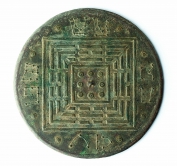
Late Tang to Song, 10th–14th cent.
Diam. 21.9 cm, rim h. 0.29 cm, w. 625 g
Art Museum Collection
Gift of Prof. MARK Kai-keung
Mark’s mirror has integrated the patterns of the houtian eight trigrams and constellations, in a manner that invites further investigation. There are eight knobs on the knob seat, plus a ninth one that is actually the loop of the mirror. The outer rim contains the houtian eight trigrams, while the outermost rim houses some unknown constellations, which are not the twenty-eight constellations we are familiar with. They are probably mysterious constellations constructed in some Daoist apocrypha.
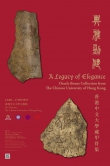
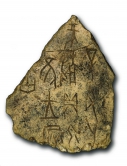
1600 BC–1046 BC
L2.8, W2.3cm
Collection of United College / The Chinese University of Hong Kong Library
Gift of Mr. C. Y. Tang
Oracle-bone script is a form of Chinese writing on turtle shells or animal bones, which in most cases refers to the characters on oracle bones from the late Shang dynasty (c. 1600–1046 BC), found at its capital of Yin (Yinxu, in present-day Anyang, Henan province). Shang oracle-bone script is the earliest known form of systematic Chinese writing and is a crucial source for understanding the development of Chinese characters as well as the history of the Shang dynasty.
This batch of forty-four oracle bones from the former collection of Deng Erya was donated to United College by his son Mr. C. Y. Tang 鄧祖玄 per the instruction of his mother, Ms. Ye Duofu in 1969. Since 2015, they have been housed in the CUHK Library. The inscriptions cover buxun (ten-day period regular divination), sacrifices, meteorology, etc.

1600 BC–1046 BC
L7.4, W2.5cm
Art Museum Collection
Gift of Yan Zhai
This batch of twenty seven oracle bones in Art Museum was donated by Prof. Lee Yim in 1984. The most-mentioned contents are sacrifices and rituals, followed by meteorology and buxun inscriptions. Back in the days, the state’s most important events were sacrifices and wars, and therefore it makes total sense to find a lot of divinatory inscriptions about sacrificial rituals in the inscriptions. On the other hand, all outdoor events, be it wars, hunting, farming, or fishing, were strongly affected by the weather, and therefore divination notes on meteorology take up a noticeable part in all inscriptions.
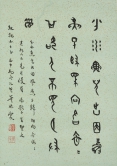
(A Ci Poem Composed to the Tune of A Southern Song)
Dated 1956
Oracle-Bone script, ink on paper, mounted
35.8 × 25.5 cm
Art Museum Collection
Gift of Mr. Paul Cheng Ming-fun
Tung Tso-pin (1895–1963) was a native of Nanyang, Henan province, and the youngest among the “Four Tangs of Oracle-Bone Studies”. He later became one of the first academicians of Academia Sinica and was the director of Institute of History and Philology after Fu Ssu-nien.
The oracle-bone calligraphy housed at Art Museum was written by Tung Tso-pin in Hong Kong during 1950s. In this particular work, Tung used an ink brush to write the characters in oracle-bone script. The beginning of the strokes was written with the tip of the brush hidden (cangfeng 藏鋒), while the end of the strokes was done with the brush tip slightly shown (chufeng 出鋒), and overall the characters ran in a smooth flow. Depending on the number of strokes, the structures of the characters vary from being upright and foursquare to slender and long.

Search for Press Releases

Current Events








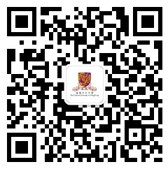




 Subscribe
to Rss Feed
Subscribe
to Rss Feed Print
Print previous
previous
